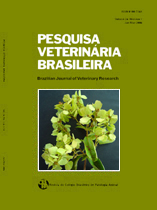 |
|
|
|
Year 2008 - Volume 28, Number 10
|

|
Occurrence of virulence-related sequences and phylogenetic analysis of commensal and pathogenic avian Escherichia coli strains (APEC), p.533-540
|
ABSTRACT.- Campos T.A., Lago J.C., Nakazato G., Stehling E.G., Brocchi M., Castro A.F.P. & Silveira W.D. 2008. Occurrence of virulence-related sequences and phylogenetic analysis of commensal and pathogenic avian Escherichia coli strains (APEC). Pesquisa Veterinária Brasileira 28(10):533-540. Departamento de Microbiologia e Immunologia, Instituto de Biologia, Unicamp, Cidade Universitrária Zeferino Vaz s/n, Campinas, SP 13081-862, Brazil. E-mail: wds@unicamp.br
The presence of iron uptake (irp-2, fyuA, sitA, fepC, iucA), adhesion (iha, lpfAO157/O141, lpfAO157/O154, efa, toxB) and invasion (inv, ial-related DNA sequences and assignment to the four main Escherichia coli phylogenetic groups (A, B1, B2 e D) were determined in 30 commensal E. coli strains isolated from healthy chickens and in 49 APEC strains isolated from chickens presenting clinical signs of septicemia (n=24) swollen head syndrome (n=14) and omphalitis (n=11) by PCR. None of the strains presented DNA sequences related to the inv, ial, efa, and toxB genes. DNA sequences related to lpfAO157/O154, iucA, fepC, and irp-2 genes were significantly found among pathogenic strains, where iucA gene was associated with septicemia and swollen head syndrome and fepC and irp-2 genes were associated with swollen head syndrome strains. Phylogenetic typing showed that commensal and omphalitis strains belonged mainly to phylogenetic Group A and swollen head syndrome to phylogenetic Group D. Septicemic strains were assigned in phylogenetic Groups A and D. These data could suggest that clonal lineage of septicemic APEC strains have a multiple ancestor origin; one from a pathogenic bacteria ancestor and other from a non-pathogenic ancestor that evolved by the acquisition of virulence related sequences through horizontal gene transfer. Swollen head syndrome may constitute a pathogenic clonal group. By the other side, omphalitis strains probably constitute a non-pathogenic clonal group, and could cause omphalitis as an opportunistic infection. The sharing of virulence related sequences by human pathogenic E. coli and APEC strains could indicate that APEC strains could be a source of virulence genes to human strains and could represent a zoonotic risk. |
| |
|
|
| |
|
 |